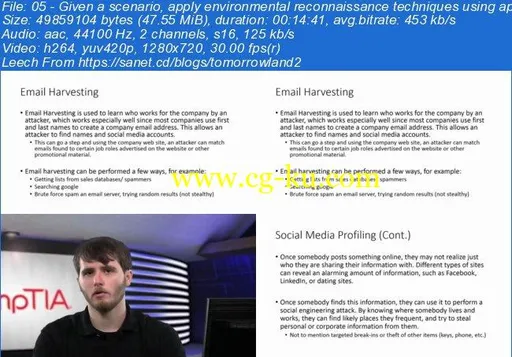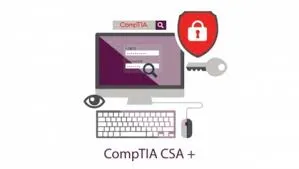Duration: 17h 55m | Video: h264, 1280x720 | Audio: AAC, 44100 Hz, 2 Ch | 3.2 GBGenre: eLearning | Language: EnglishThe CompTIA Cybersecurity Analyst, or CSA+, is a CompTIA certification focusing on the knowledge and skills required to configure and use threat-detection tools, perform data analysis, and interpreting the results with the end goal of securing an organization’s applications and systems.
The CSA+ is a vendor neutral certification that expects three to four years of experience in a related field as well as a Security+ or equivalent knowledge.
In this regard, the CSA+ lies between the security+ as well as the CompTIA Advanced Security Practitioner (CASP) exams and is an excellent go between to tackle before diving into the CASP, but when the Security+ isn’t enough.
With the ongoing requirement for government agencies to receive certifications, the CSA+ was developed with a focus on meeting government requirements to certify IT workers or contractors.
This certification will display an understanding of security best practices and protocols beyond that which is provided by the Security+ and will prove a level of expertise beyond that of basic security practices that are followed when using a computer.
This allows any employee to prove a better understanding of enterprise security practices, and the necessary tools needed to protect a company network.
The modules of this course align with the official objects of the certification and will expand past the scope of the certification to provide real life examples as well as lead ins to direct further study.
This will give students more to work off of than simple definition based review and allow for easier understanding of the material for the certification as well as a basic understanding for real life application.
Module 1: Threat Management1.1 Introduction1.2 Given a scenario, apply environmental reconnaissance techniques using appropriate tools and processes - Part 11.3 Given a scenario, apply environmental reconnaissance techniques using appropriate tools and processes - Part 21.4 Given a scenario, apply environmental reconnaissance techniques using appropriate tools and processes - Part 31.5 Given a scenario, apply environmental reconnaissance techniques using appropriate tools and processes - Part 41.6 Given a scenario, apply environmental reconnaissance techniques using appropriate tools and processes - Part 51.7 Given a scenario, apply environmental reconnaissance techniques using appropriate tools and processes - Part 61.8 Given a scenario, apply environmental reconnaissance techniques using appropriate tools and processes - Part 71.9 Given a scenario, apply environmental reconnaissance techniques using appropriate tools and processes - Part 81.10 Given a scenario, apply environmental reconnaissance techniques using appropriate tools and processes - Part 91.11 Given a scenario, analyze the results of a network reconnaissance - Part 11.12 Given a scenario, analyze the results of a network reconnaissance - Part 21.13 Given a scenario, analyze the results of a network reconnaissance - Part 31.14 Given a scenario, analyze the results of a network reconnaissance - Part 41.15 Given a scenario, analyze the results of a network reconnaissance - Part 51.16 Given a network-based threat, implement or recommend the appropriate response and countermeasure - Part 11.17 Given a network-based threat, implement or recommend the appropriate response and countermeasure - Part 21.18 Given a network-based threat, implement or recommend the appropriate response and countermeasure - Part 31.19 Given a network-based threat, implement or recommend the appropriate response and countermeasure - Part 41.20 Explain the purpose of practices used to secure a corporate environment - Part 11.21 Explain the purpose of practices used to secure a corporate environment - Part 21.22 Explain the purpose of practices used to secure a corporate environment - Part 31.23 Explain the purpose of practices used to secure a corporate environment - Part 4Module 2: Vulnerability Management2.1 Given a scenario, implement an information security vulnerability management process - Part 12.2 Given a scenario, implement an information security vulnerability management process - Part 22.3 Given a scenario, implement an information security vulnerability management process - Part 32.4 Given a scenario, implement an information security vulnerability management process - Part 42.5 Given a scenario, implement an information security vulnerability management process - Part 52.6 Given a scenario, implement an information security vulnerability management process - Part 62.7 Given a scenario, implement an information security vulnerability management process - Part 72.8 Given a scenario, analyze the output resulting from a vulnerability scan - Part 12.9 Given a scenario, analyze the output resulting from a vulnerability scan - Part 22.10 Compare and contrast common vulnerabilities found in the following targets within an organization - Part 12.11 Compare and contrast common vulnerabilities found in the following targets within an organization - Part 22.12 Compare and contrast common vulnerabilities found in the following targets within an organization - Part 3Module 3: Cyber Incident Response3.1 Given a scenario, distinguish threat data or behavior to determine the impact of an incident - Part 13.2 Given a scenario, distinguish threat data or behavior to determine the impact of an incident - Part 23.3 Given a scenario, distinguish threat data or behavior to determine the impact of an incident - Part 33.4 Given a scenario, prepare a toolkit and use appropriate forensic tools during an investigation - Part 13.5 Given a scenario, prepare a toolkit and use appropriate forensic tools during an investigation - Part 23.6 Given a scenario, prepare a toolkit and use appropriate forensic tools during an investigation - Part 33.7 Given a scenario, prepare a toolkit and use appropriate forensic tools during an investigation - Part 43.8 Given a scenario, prepare a toolkit and use appropriate forensic tools during an investigation - Part 53.9 Explain the importance of communications during the incident response process3.10 Given a scenario, analyze common symptoms to select the best course of action to support incident response - Part 13.11 Given a scenario, analyze common symptoms to select the best course of action to support incident response - Part 23.12 Given a scenario, analyze common symptoms to select the best course of action to support incident response - Part 33.13 Given a scenario, analyze common symptoms to select the best course of action to support incident response - Part 43.14 Summarize the incident recovery and post-incident response process - Part 13.15 Summarize the incident recovery and post-incident response process - Part 23.16 Summarize the incident recovery and post-incident response process - Part 33.17 Summarize the incident recovery and post-incident response process - Part 4Module 4: Security Architecture and Tool Sets4.1 Explain the relationship between frameworks, common policies, controls, and procedures - Part 14.2 Explain the relationship between frameworks, common policies, controls, and procedures - Part 24.3 Explain the relationship between frameworks, common policies, controls, and procedures - Part 34.4 Explain the relationship between frameworks, common policies, controls, and procedures - Part 44.5 Given a scenario, use data to recommend remediation of security issues related to identity and access management - Part 14.6 Given a scenario, use data to recommend remediation of security issues related to identity and access management - Part 24.7 Given a scenario, use data to recommend remediation of security issues related to identity and access management - Part 34.8 Given a scenario, use data to recommend remediation of security issues related to identity and access management - Part 44.9 Given a scenario, review security architecture and make recommendations to implement compensating controls - Part 14.10 Given a scenario, review security architecture and make recommendations to implement compensating controls - Part 24.11 Given a scenario, review security architecture and make recommendations to implement compensating controls - Part 34.12 Given a scenario, use applications security best practices while participating in the Software Development Life Cycle (SDLC) - Part 14.13 Given a scenario, use applications security best practices while participating in the Software Development Life Cycle (SDLC) - Part 24.14 Overview4.15 Conclusion



发布日期: 2017-12-26